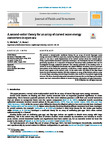A second-order theory for an array of curved wave energy converters in open sea
| dc.contributor.author | Michele, Simone | |
| dc.contributor.author | Renzi, E | |
| dc.date.accessioned | 2021-08-09T14:26:40Z | |
| dc.date.available | 2021-08-09T14:26:40Z | |
| dc.date.issued | 2019-07 | |
| dc.identifier.issn | 0889-9746 | |
| dc.identifier.issn | 1095-8622 | |
| dc.identifier.uri | http://hdl.handle.net/10026.1/17504 | |
| dc.description.abstract |
We present a second-order nonlinear theory for an array of curved flap-type wave energy converters (WECs) in open sea, excited by oblique incident waves. The flap model, when at rest, has a weak displacement of its wetted surface about the vertical plane. Using a perturbation-harmonic expansion technique, we decompose the set of nonlinear governing equations in a sequence of linearized boundary-value problems that can be investigated through analytical methods. The velocity potential at the leading order is solved in terms of elliptical coordinates and related Mathieu functions. Due to quadratic interactions of the first-order potential, a drift flow, a static angular displacement and a bound wave appear at the second order. At the same order the effect of the flap shape forces the first harmonic solution. We then compare an array of flat devices with an array of curved flaps, assuming several shape functions that could be of practical engineering interest. We show that hydrodynamic interactions between the curved flaps and incident waves can have constructive effects in terms of power absorption at large frequencies. | |
| dc.format.extent | 315-330 | |
| dc.language | en | |
| dc.language.iso | en | |
| dc.publisher | Elsevier BV | |
| dc.rights | Attribution 4.0 International | |
| dc.rights | Attribution 4.0 International | |
| dc.rights | Attribution 4.0 International | |
| dc.rights.uri | http://creativecommons.org/licenses/by/4.0/ | |
| dc.rights.uri | http://creativecommons.org/licenses/by/4.0/ | |
| dc.rights.uri | http://creativecommons.org/licenses/by/4.0/ | |
| dc.subject | Wave energy | |
| dc.subject | Wave-structure interactions | |
| dc.subject | Resonance | |
| dc.title | A second-order theory for an array of curved wave energy converters in open sea | |
| dc.type | journal-article | |
| dc.type | Journal Article | |
| plymouth.author-url | https://www.webofscience.com/api/gateway?GWVersion=2&SrcApp=PARTNER_APP&SrcAuth=LinksAMR&KeyUT=WOS:000477786900018&DestLinkType=FullRecord&DestApp=ALL_WOS&UsrCustomerID=11bb513d99f797142bcfeffcc58ea008 | |
| plymouth.volume | 88 | |
| plymouth.publication-status | Published | |
| plymouth.journal | Journal of Fluids and Structures | |
| dc.identifier.doi | 10.1016/j.jfluidstructs.2019.05.007 | |
| plymouth.organisational-group | /Plymouth | |
| plymouth.organisational-group | /Plymouth/Faculty of Science and Engineering | |
| plymouth.organisational-group | /Plymouth/Faculty of Science and Engineering/School of Engineering, Computing and Mathematics | |
| plymouth.organisational-group | /Plymouth/Users by role | |
| plymouth.organisational-group | /Plymouth/Users by role/Academics | |
| dc.identifier.eissn | 1095-8622 | |
| dc.rights.embargoperiod | Not known | |
| rioxxterms.versionofrecord | 10.1016/j.jfluidstructs.2019.05.007 | |
| rioxxterms.licenseref.uri | http://creativecommons.org/licenses/by/4.0/ | |
| rioxxterms.type | Journal Article/Review |



